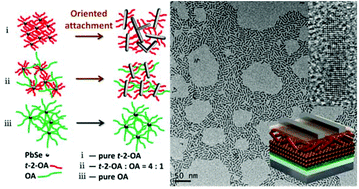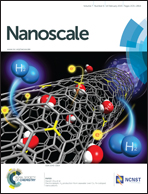Facile synthesis of ultra-small PbSe nanorods for photovoltaic application†
Abstract
Nanocrystal array solar cells based on lead chalcogenide quantum dots (QDs) have recently achieved a high power conversion efficiency of over 8%. The device performance is expected to further increase by using 1-dimensional nanorods (NRs), due to their improved carrier transport over zero-dimensional quantum dots. However, previously reported PbSe NRs have not been used in solar cells mainly because of their large diameters, resulting in a small bandgap unsuitable for photovoltaic application. In this work, we have demonstrated a new method for synthesizing monodisperse ultra-small PbSe NRs with the diameter approaching 2 nm (Eg > 1.2 eV), which can be attributed to the use of diphenylphosphine (DPP) and trans-2-octenoic acid (t-2-OA). The introduction of trace DPP can greatly lower the reaction temperature, leading to reduced diameters for the obtained PbSe NRs as well as largely increased yield. The use of short-chain t-2-OA together with oleic acid as capping ligands results in high monomer reactivity, fast nucleus diffusion and high growth rate, which realize the anisotropic growth of ultra-small PbSe NRs at low reaction temperatures. The PbSe NRs show n-type properties and high electron mobility as measured using field-effect transistors. The PbSe NRs with narrow diameters also demonstrate a suitable bandgap for photovoltaic application. They are used for the first time in solar cells and their improved efficiency is demonstrated when used together with QDs.


 Please wait while we load your content...
Please wait while we load your content...